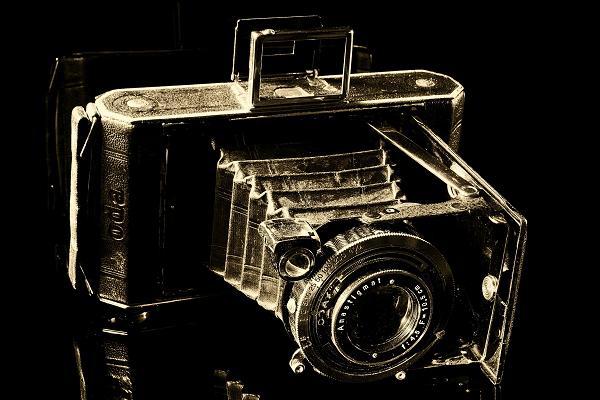Part One: Ante-Third Reich
Motion pictures were initially developed in the 1870s by the British American photographer Eadweard Muybridge, building on France’s Louis-Jacques-Mandé Daguerre’s development of the positive photographic process and on England’s William Henry Fox Talbot’s negative photographic process, in order to prove the theory of the wealthy horse breeder and then governor of California, Leland Stanford, that all four hooves of a galloping horse leave the ground simultaneously.
Following the more than 35 years in which such films developed as popular novelties and ever more sophisticated curiosities without any serious artistic or narrative content, the notion of telling stories with motion pictures arose. Germany was a leader in that movement and in 1910 began to produce a series of tasteful, distinctive, insightful, and reflective films based on stories.
One particularly effective example is the 1913 production of Edgar Allan Poe’s The Student of Prague, produced by Deutsche Bioscop GmbH (later bought outright by Babelsberg Studio along with affiliated production companies) and filmed in Berlin. Today, Babelsberg Studio in Potsdam-Babelsberg, on the outskirts of Berlin, is the financial and production center not only for German filmmaking, but also for a majority of international, high-budget films. It is the focal point of German artistic and professional filmmaking development.
Films such as The Student of Prague had a profound effect on viewers who were used to still photographs that captured the true “Kodak moments” of their lives, i.e., that portrayed people, locations, and events that marked incidents in their own lives. Viewers often transferred this reinforced belief in their own photographs to the stories told through motion pictures, as if the plots, characters, locales, etc. were real, i.e., viewers “willingly suspended their disbelief” (“freiwillige Aussetzen der Zweifel”). This aspect of filmmaking brought acceptance and much success to the motion picture industry. Technological developments attributed to German filmmakers include the early projector and sound-on-film and contributed greatly to German filmmaking successes.
Filmmaking in World War I
World War I gave rise to the use of filmmaking to promote propaganda which promoted the fatherland and denigrated the enemy. This new tack brought about the establishment of Universum Film AG (“UFA GmbH”) by the German military, ostensibly to combat foreign film competition, but also to promote German national interests and to coordinate and refine propaganda on behalf of the fatherland. Because the war affected imports of foreign films, German filmmaking quickly took over all aspects of the German film market: documentaries, weekly news reviews, feature films, etc., mixed with and influenced by the ever more sophisticated propaganda films.

After the war, UFA trended away from propaganda towards more commercially viable projects and, in the process, many German directors, executives, and stars, e.g., Ernst Lubitsch, Erich Pommer, Emil Jannings, Pola Negri, Conrad Veidt, and Lya de Putti, became more prominent and German filmmaking competed directly with Hollywood. Unfortunately, in 1923 a series of poor business decisions brought UFA to the brink of bankruptcy and only a massive injection of capital by new owners and a restructuring of both its business model and its marketing plans managed to save it at the last minute. After seven years of hard work and planning, UFA seemed to have weathered the economic storm.
On the creative front during this time, imaginative and ambitious German filmmakers stressed social issues and pragmatic rather than theoretical political matters presented in a documentary style that contributed to each film’s verisimilitude. They replaced conventional filmmaking techniques with radical camera techniques, editing, and unconventional visual presentations. A film’s storyline was no longer the sole source of information for the viewer. The way a filmmaker told a story was as important and as effective as the story itself and, as often as not, the filmmaker never resolved the story’s conflict, leaving it to the viewer to create his/her own resolution—or lack of one—based on the realism, the ambiguity, and the viewer’s personal experience and imagination. In effect, the fourth wall was breached to make each viewer a participant in the story.
German Expressionism
German filmmakers first brought expressionism—the effective use of realism, imagery, and symbolism to evoke viewers’ interests and attention—to the screen, most notably The Cabinet of Dr. Caligari (Robert Wiene), Nosferatu (Murnau), and The Golem: How He Came Into the World (Boese & Wegener) and its development had a powerful effect on international filmmaking, particularly in France and the U.S.
New Objectivity
German expressionism gave way to social themes and realism which unabashedly spotlighted very controversial themes. It evolved into so-called new objectivity (“Neue Sachlichkeit”), a filmmaking school which focused on the average, even mundane, lives of ordinary Germans as they related to the various components of society, e.g., literature, politics, commercialism, art, education, etc. It highlighted the average German man-in-the-street’s pragmatic, day-to-day goings-on rather than on the philosophical aspects of their lives. It also dealt bluntly with many quite controversial topics—topics that continue to plague societies worldwide even today: illegal drugs, prostitution, abortion, homosexuality, etc.
German filmmakers then began to chronicle man’s struggle with nature, after which German filmmakers introduced animation, and then spectacular historical films which stirred patriotic feelings, finally ending up with so-called chamber dramas which provided an intimate examination of the bleak, desolate lives and petty dramas of ordinary people. This somewhat mediocre artistic vein petered out as the Weimar Republic began its inglorious downhill slide in the few years before the Great Depression and war gripped Europe. Part Two will discuss the years commencing with Hitler’s rise, through the war, and the fall of Nazism.
